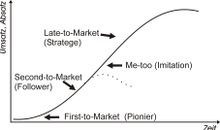Copycat product
A copycat product (also me-too product , from English me too , ' me too ') is understood to mean products that are similar to a mostly innovative original product in many properties and capabilities and, if the first supplier succeeds - as soon as possible afterwards Market come.
The original is often the market leader or has only created this market. Imitation products from so-called market followers address the same or a similar group of customers that the original serves, but do not represent plagiarism in legal terms (in contrast to product piracy ). Similar packaging or cover pictures and slightly different spellings are also typical, so that these products can definitely be mistaken for the original if they are not carefully purchased.
If the market is regularly and specifically observed and interesting innovations are copied when the opportunity arises, this is also called a me-too strategy (in contrast to the innovation strategy ).
Examples and areas of application
In the pharmaceutical market , imitation products distinguish between generics , which contain identical active ingredients that are no longer protected by patents , and analogue preparations that differ from the original product in terms of the active ingredient structure, but without showing any relevant difference to established products.
In the television industry, one speaks of me-too formats . German or Austrian production companies often imitate US formats (e.g. Sex and the City - Everything but Sex ; or The Simpsons compared to Family Guy ). So the RTL show Wer wird Millionär? the quiz is new on German television, which is why a little later on ARD Das Quiz with Jörg Pilawa , conceptually similar, went on air.
In the food sector, there are substitute foods that are based on a certain imitation (for example, Muckefuck as a coffee substitute without caffeine, mostly made from grain). In discounter is called often find no-name products .
Individual evidence
- ↑ Matys, Erwin. Practical manual product management: Basics and instruments. Campus Verlag, 2013. p. 339.
- ↑ Andreae, Susanne, Dominik von Hayek, and Jutta Less. Health and disease studies for the elderly. Georg Thieme Verlag, 2011. p. 93.
- ↑ Deuerling, Tanja. "Innovation management for new television." Development of moving image formats depending on the degree of innovation, Wiesbaden (2015). P. 228.
- ↑ Hartwig, Stefanie. Advertising for food: strategies-legal leeway-implementation. Behr's Verlag DE, 2013. P. 51.
Web links
- Me-too product - Article in the Gabler Wirtschaftslexikon
